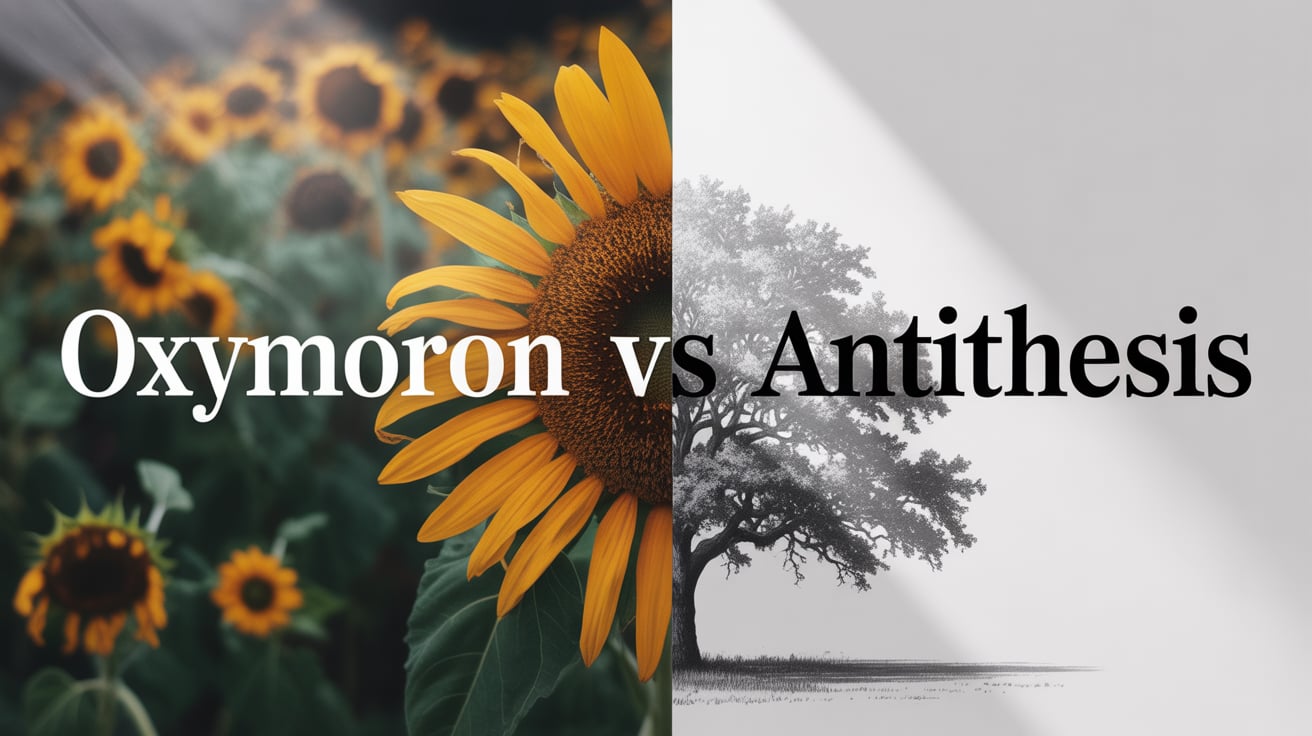Language is full of tools that make writing more memorable. Two of the most effective are the oxymoron and the antithesis.
They might seem similar — both involve opposites and both grab attention. But they’re not the same thing. Understanding the difference between oxymoron and antithesis can make your writing sharper and your ideas clearer.
Let’s break them down in plain English.
What’s an Oxymoron?
An oxymoron is a figure of speech where two contradictory terms are placed together in the same phrase.
The contrast is packed into just a couple of words. It makes the reader pause and think.
Example: “Deafening silence.”
How can silence be deafening? The contradiction is what makes it interesting.
Everyday Examples of Oxymoron
| Common Speech | Literature | Advertising |
|---|---|---|
| Jumbo shrimp | “Parting is such sweet sorrow” — Shakespeare | “Seriously fun” |
| Bittersweet | “Darkness visible” — John Milton | “Awfully good” |
| Living dead | “Sweet tyrant” — Romeo and Juliet | “Clearly confused” |
Oxymorons are short, punchy, and often poetic.
Where the Word Comes From
The origins of oxymoron go back to ancient Greece. The term combines oxys (“sharp”) and moros (“foolish”). That’s an oxymoron in itself — “sharp foolishness.”
Writers have been using oxymorons for centuries to add depth and surprise to their words. Shakespeare was one of the best at it.
What’s an Antithesis?
An antithesis is different. It’s a rhetorical device that sets two contrasting ideas against each other in a parallel structure.
It’s not about two words — it’s about two complete thoughts.
Example: “It was the best of times, it was the worst of times.” — Charles Dickens
The power comes from the balance and rhythm of the sentence.
Examples of Antithesis
| Speeches | Literature | Marketing |
|---|---|---|
| “Ask not what your country can do for you — ask what you can do for your country.” — JFK | “To err is human; to forgive, divine.” — Alexander Pope | “More saving. More doing.” |
| “We must learn to live together as brothers or perish together as fools.” — Martin Luther King Jr. | “Love is an ideal thing, marriage a real thing.” — Goethe | “Think small.” |
Antithesis is all about contrasting ideas in a way that’s balanced and memorable.
Where the Word Comes From
The origins of antithesis are also Greek. Anti means “against,” and thesis means “position” — literally, “opposite position.”
Greek and Roman speakers used antithesis in debates and speeches to make their points stronger.
Oxymoron vs Antithesis: A Quick Comparison
Here’s how they stack up:
| Feature | Oxymoron | Antithesis |
|---|---|---|
| What it is | Two contradictory terms in one phrase | Two contrasting ideas in a sentence or passage |
| Length | Usually 2–3 words | Full sentence or longer |
| Purpose | Add irony, humor, or complexity | Highlight a clear contrast |
| Common Use | Poetry, slogans, creative writing | Speeches, persuasive writing |
Think of oxymoron as word-level contrast and antithesis as idea-level contrast.
How to Use Them
Using Oxymoron
- Pick words that reveal something deeper, not just opposites.
- Avoid overused phrases like “pretty ugly.”
- Use them sparingly for more impact.
Example: A coffee ad calls its blend “bitter bliss” — a perfect fit for the taste and feeling coffee gives.
Using Antithesis
- Keep the parallel structure — that’s what makes it work.
- Make sure your ideas are true opposites.
- Great for speeches, debates, and persuasion.
Example: “Feed the mind, fight the hunger.” Short, balanced, and clear.
Using Both Together
You can combine them for extra punch.
Example:
“In the deafening silence of the courtroom, justice and injustice stood side by side.”
Here, deafening silence is an oxymoron, while justice vs injustice is an antithesis.
Common Mistakes
- Mixing them up: Remember — oxymoron is a short phrase; antithesis is a full contrast.
- Overcomplicating things: Don’t use words just to sound fancy.
- Using them without purpose: If they don’t help your point, skip them.
Where They Work — and Where They Don’t
✅ Best places to use them:
- Speeches
- Literature
- Branding
❌ Avoid in:
- Legal documents
- Technical manuals
- Straight news reporting
Key Takeaway
The difference between oxymoron and antithesis is simple:
- Oxymoron = contradictory terms in one phrase.
- Antithesis = contrasting ideas in balanced sentences.
Use them well, and they can turn ordinary writing into impactful expression.
I can make this even more readable by adding a one-glance infographic that shows the difference visually. That would make it stick in the reader’s mind.
